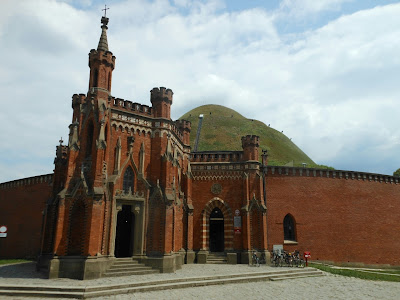30 July - 01 August
The remainder of my time in Kraków, aside from exploring the Jewish history of the city (see
Part 1), was spent with some quite different experiences. Kraków is a very gorgeous city, and in my opinion deserves more attention on the tourist trail than it gets.
The central old city is surrounded by defensive walls, and it's main square is (of course) host to an impressive cathedral and town hall buildings. When I was there, there was also a leg of the Tour de Pologne cycle race starting in the main square.
 |
| St Florian's gate in the city walls |
 |
| Cyclists preparing for a leg of the Tour de Pologne in the Stare Miasto (old town centre). There must have been some fmaous riders, because lots of people were getting photos and signatures. |
On another day, on the suggestion of Melody (who I'd met in Katowice), I headed to Nowa Huta. Literally meaning "new steel mill", Nowa Huta was built by the communist regime in 1949 as a satellite town to Kraków, and is a striking example of what life under the communists would have been like - strictly organised, industrial, and if the buildings were anything to go by, damned dull.
 |
| Almost every single building looked exactly like this - boring and grey |
The massive steel mill from which the town gets it's name is located on its outskirts. It's so big, the workers take buses inside the mill to get to their jobs. It is still operating, but the original name - Vladimir Lenin Steelworks - was, understandably, replaced with the fall of Communism.
 |
| "Huta im. Lenina" is no more |
Nowa Huta was host to a large number of demonstrations and street protests - some of which turned very violent - relating to the Solidarity movement in Poland, which led to the fall of communism in the country. A massive statue of Lenin was situated in Nowa Huta's main square, and thousands turned out when it was pulled down in 1989. Nowa Huta also has a fascinating church - which was very controversial when first built during the communist regime.
 |
Arka Pana ("Lord's Ark") church with a statue of Pope John Paul II.
The Pope was Polish and a previous Archbishop of Kraków, when he was known as Bishop Karol Wojtyla. He consecrated the church in 1977, but he was not permitted to visit it after becoming Pope in 1978. |
In Nowa Huta I also discovered some of the unusual small wooden churches typical of southern Poland. Representing medieval architecture, a number of them are even UNESCO world heritage sites (though not this one).
 |
| Parafia rzymskokatolicka św. Bartłomieja (Parish of St Bartholomew) - a tiny wooden church typical in southern Poland |
During my evenings in Kraków, I got to sample a small taste of Polish nightlife - including a
zapiekanki - bugger the McDonald's burger or Subway, this bread is the local fast food favourite! I also found another excellent jazz bar, U Muniaka, with another excellent basement performance, which I enjoyed with 2 Canadians from my hostel.
 |
| Zapiekanki |
My last day in Kraków, I had two more things on my list. The first was a walk to the Kościuszko Mound. Polish people seem to like constructing commemorative mounds - literally just large mounds built on the land - for important people, and I'd previously climbed the Krakus Mound near the Podgórze ghetto. While the Krakus and Wanda mounds were built many hundreds of years ago, this one, built in 1823, commemorates Tadeusz Kościuszko, a Polish hero who led the Polish army against the Russians in the late 1790s. Interestingly, he is also an American war hero, having fought in the American Revolutionary War in the 1770s.
The mound is now surrounded by fortifications built by the Austrians in the 1850s. It was also extensively repaired after severe rains in the 1997, with start of the art drainage systems and waterproofing membranes... All for a mound of dirt! The location, on top of a hill, also gave commanding views over the city...
 |
| Kopiec Kościuszki (Kościuszko Mound) & its fortifications |
 |
| Views from Kopiec Kościuszki over Kraków |
Back in town, I visited the dominant Kraków Wawel, a large complex including the Royal Wawel Castle and the Wawel Cathedral, perched on a dominant hill overlooking the Vistula River. The Wawel has variously served as the location of royal coronations, the seat of the president, and also the residence of Nazi Governor General Hans Frank during the existence of the
Generalgouvernement (of which Kraków was the capital) during World War II. It is now a also a national museum.
 |
| Kraków Wawel by the Vistula River |
 |
| Kraków Wawel |
 |
| Wawel Cathedral |
I had a night train booked to Vienna, in Austria, and so filled in the remainder of the evening journal writing by the river... And was rewarded with a stunning riverside sunset. Then it was off on the night train - something I'd never done, but surely it couldn't be as bad as overnight buses in Peru?
 |
| Sunset on the Vistula River - and on my stay in Poland |
 |
| The surprisingly comfortable and spacious overnight train berth to Vienna |
So, once again, just as I'd got used to the place I was visiting, it was time to move on. 6 days in Poland really wasn't enough, and I think it deserves more visitors than it gets. The history is fascinating, and the cities and architecture are every bit as impressive as the "highlight" cities that are more popular. However - onwards to Austria!














No comments:
Post a Comment